February 2025
The global CRISPR-based gene editing market size is calculated at USD 4.46 billion in 2025 and is forecasted to reach around USD 13.39 billion by 2034, accelerating at a CAGR of 13.00% from 2025 to 2034. The North America market size surpassed USD 1.66 billion in 2024 and is expanding at a CAGR of 11.07% during the forecast period. The market sizing and forecasts are revenue-based (USD Million/Billion), with 2024 as the base year.
The global CRISPR-based gene editing market size was estimated at USD 4.04 billion in 2024 and is predicted to increase from USD 4.46 billion in 2025 to approximately USD 13.39 billion by 2034, expanding at a CAGR of 13.00% from 2025 to 2034. The increased demand for target medical treatment solutions is driving the market. The advancements in gene editing technologies and growth in the biotechnology sector are boosting the CRISPR-based gene editing research and development.
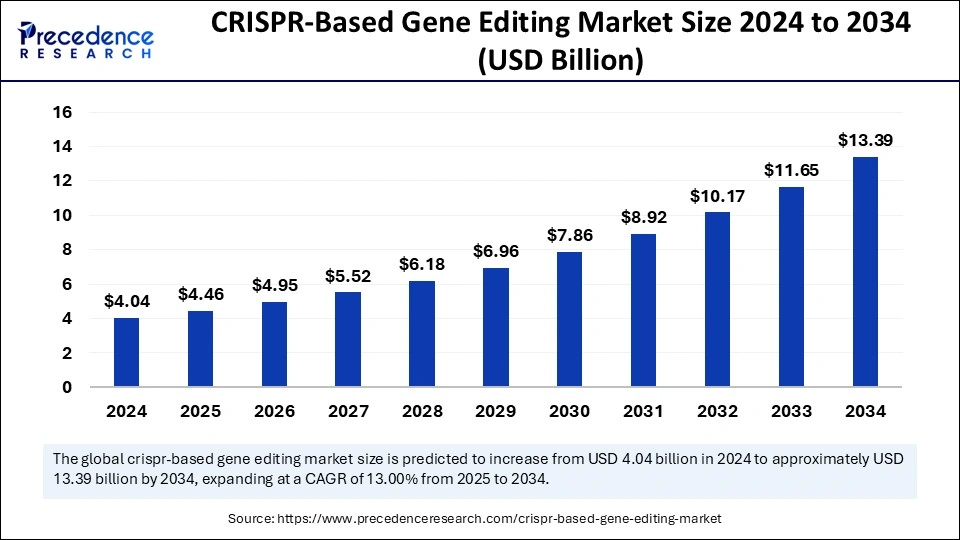
The integration of Artificial Intelligence has a significant impact on the CRISPR-based gene editing market by enhancing gene editing precision, efficiency, and safety. The AI algorithm predicts the most effective guide RNA/DNA sequence for gene editing. AI models can reduce the risk of off-target events by predicting through analyzing genomic data. AI algorithms can help in developing novel gene editors by identifying the most suitable gene for editing.
Optimizing gene editing conditions, analyzing and predicting possible risks, and providing real-time monitoring help to enhance the efficiency and safety concerns of the CRISPR-based gene editing therapies. Automated data analytics and standardizing protocols help to reduce complexity and improve productivity, so AI is becoming a more acceptable and preferred tool in clinical trials. AI is gaining popularity in CRISPR-based gene editing to improve safety, optimize experiences to increase efficiency, and maintain clinical trial standardization.
The U.S. CRISPR-based gene editing market size was exhibited at USD 940 million in 2024 and is projected to be worth around USD 2.95 billion by 2034, growing at a CAGR of 12.30% from 2025 to 2034.
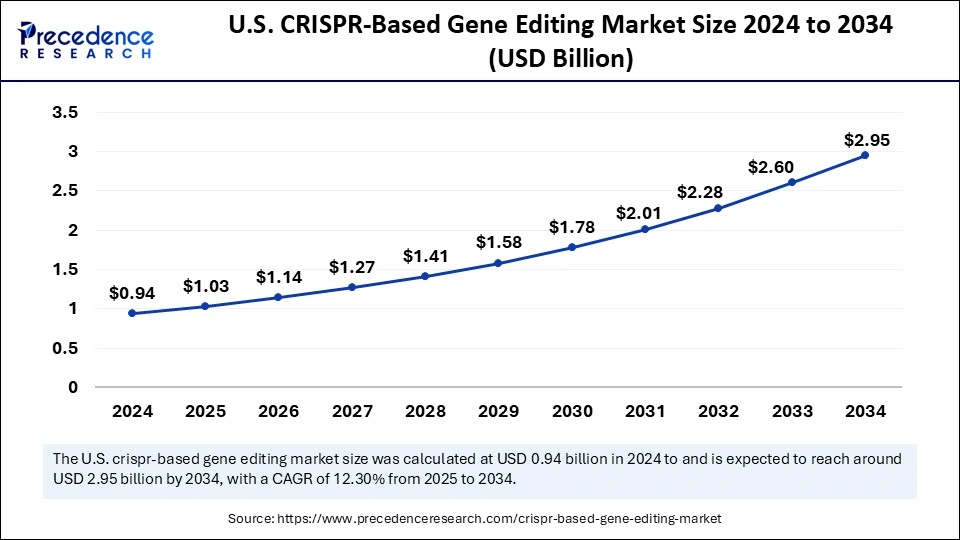
North America: Early Adopter of CRISPR-based Gene Editing Technology
North America dominated the CRISPR-based gene editing market in 2024. North America is the early adopter of CRISPR gene editing technology. The presence of strong research and development institutes, as well as companies investing in the R&D ecosystem and innovation in CRISPR-based gene editing, is high in the region. Additionally, the presence of key market vendors and a favorable regulatory environment, with U.S. FDA approvals for novel development and approaches of CRISPR gene editing therapies, contributed to market growth. The existence of strong gene therapy businesses, such as those in biotechnology, the pharmaceutical industry, and research institutes, makes them the major adopters of CRISPR-based gene editing technology.
The United States is leading the regional market due to the presence of the major key players in the country. The United States has encouraged major agriculture industries to work on CRISPR-edited crop commercialization. Government initiatives and investments in biotechnology and the research and development sector allow advancements in the technology. With the increased incidence of genetic diseases and the support of government and regulations, the market is expected to continuously grow in the region.
Regulatory Initiatives Boosting Technology Research and Development in Asia
Asia Pacific is expected to grow at a significant CAGR in the CRISPR-based gene editing market over the forecast period. Asia Pacific has witnessed a rapid expansion of the biotechnology industry, driven by highly skilled workforces, government support, and investments. The increasingly significant investment in research and development is fueling the CRISPR-based gene editing technology innovations. Growth in biotechnology and pharmaceutical companies has been initiated to comply with the growing demand for innovative therapies in the region's advancing healthcare infrastructure. With favorable regulatory environments, the funding and support for CRISPR-based gene editing research and development have been estimated.
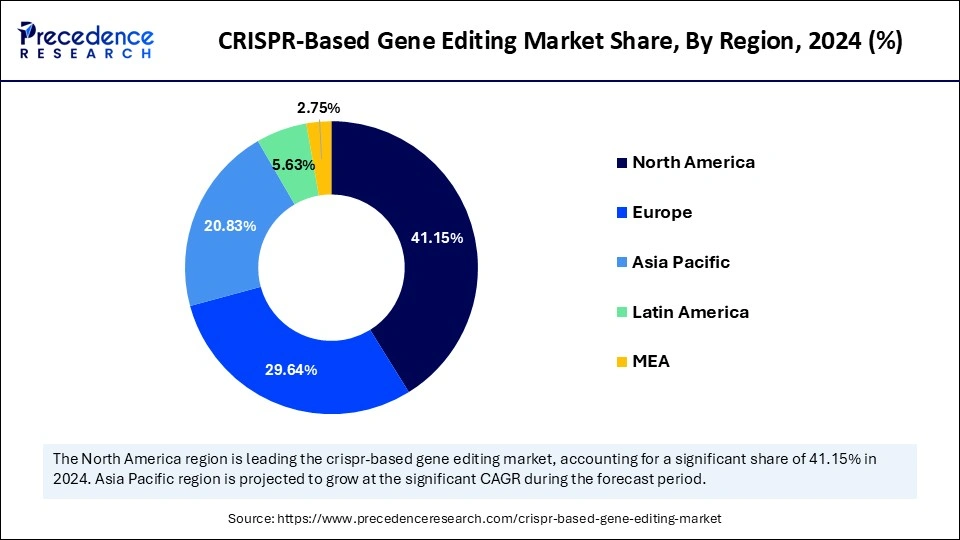
China is the largest market for CRISPR-based gene editing technology in the Asia Pacific. China is rapidly emerging as a global leader in CRISPR research, with heated competition with the United States. The large and expanding biotechnology industry, the presence of key vendors, a favorable regulatory ecosystem, and government support and funding for CRISPR gene editing innovation and development are significant factors contributing to the market growth. Industries like biotechnology, pharmaceuticals, and agriculture are the major adopters of CRISPR-based gene editing technology in China.
European Robust Research Sector Drives the Market
Europe is witnessing notable growth in the global CRISPR-based gene editing market due to the region's robust research institutes and collaboration between research, universities, and pharmaceutical companies. A favorable regulatory environment and government support, and funding for research and development are the key factors contributing to market growth. Europe approaches significant activities to facilitate the approval of gene editing therapies and to create further opportunity space for the market. Germany is leading the market with the country's increased focus on precision medicine. The significant investments in genomic research, such as cancer treatments and regenerative medicine, drive the market expansion in Germany.
The CRISPR-based gene editing market is growing rapidly, mainly due to increased awareness and diagnosis of genetic disorders, such as cystic fibrosis, sickle cell disease, and muscular dystrophy. CRISPR-based gene editing is the technology that allows scientists to precisely modify DNA by using “molecular scissors” called Cas9. The increased genetic disease prevalence drives demand for effective gene editing technologies like CRISPR. The need for advanced delivery methods and safety profiles, along with a preference for CRISPR-based gene editing technology. Biotechnology industries are the major applications of CRISPR-based gene editing technologies, widely used for studying genes and their functions, creating disease models, and developing novel therapies.
The increased demand for personalized medicines is driving the adoption of CRISPR-based gene editing technology to treat genetic diseases. The rapid utilization of this technology in agriculture further contributes to the market growth. This technology can help to improve crop yields, improve nutritional content, and improve disease-resistance abilities. Growing investments and support for gene editing research and development are allowing access to CRISPR-based gene editing approaches. Additionally, ongoing collaborations between research institutes, universities, pharmaceutical and biotechnology companies, and government institutes are emerging novel opportunities for the technology.
| Report Coverage | Details |
| Market Size by 2034 | USD 13.39 Billion |
| Market Size in 2025 | USD 4.46 Billion |
| Market Size in 2024 | USD 4.04 Billion |
| Market Growth Rate from 2025 to 2034 | CAGR of 13.00% |
| Dominating Region | North America |
| Fastest Growing Region | Asia Pacific |
| Base Year | 2024 |
| Forecast Period | 2025 to 2034 |
| Segments Covered | Product, Gene Editing Modality, Technology, Application, End User, and Regions. |
| Regions Covered | North America, Europe, Asia-Pacific, Latin America, and Middle East & Africa |
High prevalence of genetic disorders
The increased prevalence of genetic disorders is the major driver of the global CRISPR-based gene editing market. The incidence of genetic disorders such as sickle cell anemia, cystic fibrosis, and muscular dystrophy has rapidly increased around the globe, driving the adoption of CRISPR-based gene editing technology. Ongoing advancements in CRISPR technologies enhance safety, precision, and efficacy, making them ideal treatment solutions for genetic disorders.
Awareness of genetic disorders has increased. However, the lack of treatment solutions for genetic diseases has driven attention toward the potential of CRISPR-based gene editing solutions. Additionally, CRISPR technology can provide disease detection and monitoring and help to develop personalized therapies depending on individual genetic profiles.
Efficiency and safety concerns
CRISPR-based gene editing can sometimes edit unintended genome parts, leading to off-target effects. This can further create mosaicism and non-specific and hazardous gene modifications. The risk of CRISPR to genomic instability and trigger an immune response, leading to unintended changes to the genome, inflammation, and other adverse effects. The precision-driven therapies face major off-target consequences. Additionally, the evaluation of viral delivery systems has created controversy over adverse events following clinical trials. The CRISPR-based gene editing technology needs to advance efficient and safe delivery systems.
Technological advancements in base editing and prime editing
The CRISPR-based gene editing technology is transforming novel approaches through advancements in base and prime editing using CRISPR-Cas9 technology. These technological advancements enable more precise and versatile genetic modifications. Base editing allows direct and irreversible conversion of one DNA base to another without making a double-stranded break in the genome. Prime editing combines CRISPR technology with base editing, allowing more precise and efficient gene editing.
The increased need for safer and more reliable options for gene editing is taking place. Advancements in base and prime editing enable more flexibility and safety of CRISPR technology. Base and prime editing is considered ideal for therapeutic application to treat genetic diseases like sickle cell anemia and muscular dystrophy. Advancements in base and prime editing improve CRISPR technology capabilities for the development of new therapeutic and agricultural applications.
The kits and reagents segment held the biggest CRISPR-based gene editing market share in 2024. The demand for kits and reagents, including CRISPR kits, enzymes, and libraries, has increased, driven by their essential role in research and applications. The expanding research in gene editing tools is driving the need for kits and reagents. The various applications of kits and reagents in agriculture research, disease research, and biomedical research are increasing the adoption rate. Under the services segment, the CRISPR kits sub-segment dominated. The CRISPR kits are specifically created to show the entire spectrum of gene editing products in the CRISPR reaction. The increased adoption of CRISPR kits in CRISPR technology-based drug discovery and gene therapy fueling the segment growth.
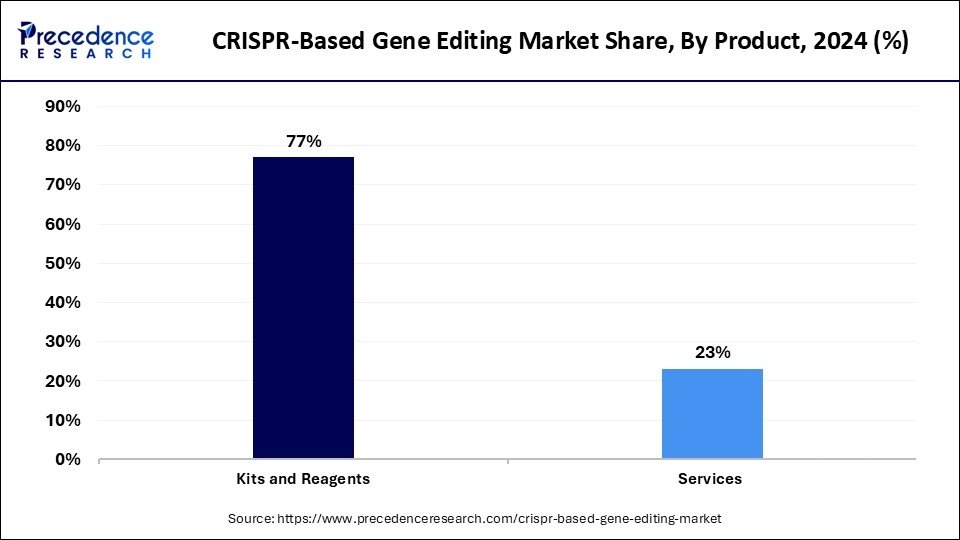
The services segment is expected to grow at the fastest CAGR over the forecast period due to increased demand for outsourcing gene editing services for precise and efficient gene editing solutions. Gene editing is a complex procedure that requires specialized expertise and equipment. The need for outsourcing gene editing services has increased due to its cost-effective nature with high capabilities for small and medium-sized research institutes and biotechnology companies.
Under the services segment, the contract research organizations (CRO) sub-segment held a significant share. The risk of R&D complexity, the need for skilled workforces, and increased demand for outsourcing research activities drive demand for Contract Research Organizations (CROs) services in clinical trials and genetic data management.
CRISPR-Based Gene Editing Market Revenue, By Product 2023-2024 (USD Million)
| Product | 2023 | 2024 |
| Kits & Reagents | 2,830.64 | 3,101.46 |
| Services | 839.36 | 935.54 |
The ex vivo editing segment led the CRISPR-based gene editing market in 2024 due to rapid advancement in clinical trials and base and prime technologies. The ex vivo editing modality allows precise and controlled gene editing to reduce the risk of off-target effects. Flexibility, control, and versatility of ex vivo editing have generated a spectacular impact on therapeutic approaches for sickle cell anemia and β-thalassemia and in developing CAR-T therapies for cancer. Safety, technical feasibility, and targeted condition advantages of ex-vivo editing are increasing the popularity. Also, ex vivo editing has less strict regulatory requirements compared to in vivo editing.

However, the in vivo editing segment is estimated to grow at the fastest CAGR over the forecast period. The direct gene editing nature of in-vivo editing helps to reduce the need for ex-vivo editing, cell transplantation, and cell extraction, making them promising avenues for therapeutic applications. In-vivo editing reduces the risk of complexity and improves efficacy by allowing precise and efficient gene editing. The use of in vivo editing has increased in the treatment of genetic diseases, cancer, and infectious diseases.
CRISPR-Based Gene Editing Market Revenue, By Gene Editing Modality 2023-2024 (USD Million)
| Gene Editing Modality | 2023 | 2024 |
| Ex Vivo Editing | 1,950.08 | 2,153.45 |
| In Vivo Editing | 1,719.92 | 1,883.55 |
The CRISPR/Cas9 technology segment dominated the global CRISPR-based gene editing market in 2024. The segment growth is accounted for due to its wide adoption in research and development. The Cas9 is a powerful technology for research, clinical trials, and potential therapeutic applications. These technologies reduce disrupting of disease-causing genes with great precision and efficiency. The advancements in CRISPR-associated protein 9 (Cas9) gene-editing technology are expected to enhance permanent disease-treating capabilities.
The CRISPR/Cas12 technology segment is projected to grow at the fastest rate during the forecast period. The adoption of CRISPR/Cas12 Technology has increased in the agriculture and biomedicine industries. This technology is highly efficient and specific in gene editing applications. Cas12 technology allows gene editing without separating guide RNA, which makes it advantageous for an efficient and more streamlined process. Cas12 technology is being used for various applications, including gene therapy, cancer, and agricultural biotechnology.
CRISPR-Based Gene Editing Market Revenue, By Technology, 2023-2024 (USD Million)
| Technology | 2023 | 2024 |
| CRISPR/Cas9 Technology | 2,039.78 | 2,239.11 |
| CRISPR/Cas12 Technology | 504.48 | 551.67 |
| CRISPR/Cas13 Technology | 237.81 | 256.94 |
| Base Editing | 626.91 | 704.04 |
| Prime Editing | 163.90 | 181.69 |
| Epigenetic Editing | 65.69 | 69.93 |
| Others | 31.41 | 33.63 |
The therapeutic applications segment contributed the highest CRISPR-based gene editing market share in 2024 due to the increased prevalence of genetic disease and demand for personalized medicines. The adoption of CRISPR-based gene editing therapy has increased research and developments and clinical trials for developing novel, safe, and efficient therapies. Additionally, technological advances such as improved efficiency, specificity, and safety draw scientists' attention toward them. Regulatory support for CRISPR-based gene editing research and development plays a vital role in segment growth.
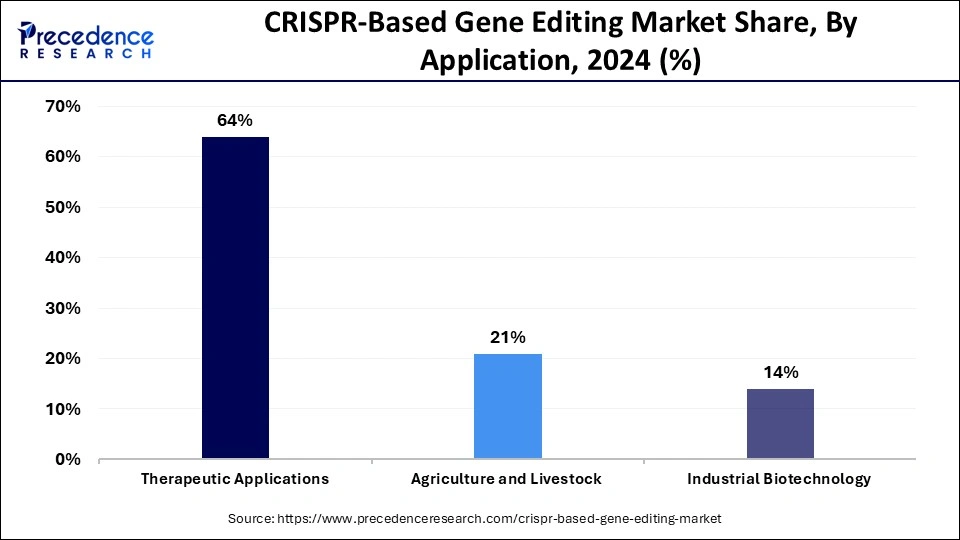
Under the therapeutic application segment, the gene therapy sub-segment held a significant share. Gene therapy has the largest market share, driven by the increased use of the advent of CRISPR technology for the treatment of genetic disorders. Biotechnology and pharmaceutical companies are heavily investing in the research and development of CRISPR-based gene therapies. However, the cancer therapy segment will grow rapidly in the upcoming period due to increasing developments of CRISPR-based gene editing techniques for cancer treatments. CRISPR-based gene editing techniques are rapidly being used to repair mutations or deletions in tumors. The ongoing CRISPR-based gene editing technology engineering CAR-T cells with enhanced anti-cancer capabilities holds immense promise for the future.
The agriculture and livestock segment is expected to show the fastest growth over the projected period. The segment growth is poisoned due to the increased adoption of CRISPR-based gene editing technology in agriculture and livestock applications, including improved crop yield, productivity, disease resistance, and nutritional value. The growing global population and need for food production. The trend for sustainable agriculture and nutritionist animal food is driving demand for CRISPR technology in agriculture and livestock areas.
Under the agriculture and livestock segment, the cancer therapy segment held the largest share. The adoption of CRISPR technology has witnessed rapid growth in agriculture applications such as crop improvements to enable precise and efficient modifications. CRISPR technology provides herbicide tolerance, pest resistance, and drought tolerance properties to the crops. The CRISPR-based gene editing technology helps to improve capabilities of disease resistance, yield value, and nutritional value, ultimately boosting agricultural productivity and sustainability.
CRISPR-Based Gene Editing Market Revenue, By Application, 2023-2024 (USD Million)
| Application | 2023 | 2024 |
| Therapeutic Applications | 2,345.63 | 2,585.90 |
| Agriculture & Livestock | 777.52 | 866 |
| Industrial Biotechnology | 546.85 | 585.10 |
The biotechnology and pharmaceutical companies segment dominated the CRISPR-based gene editing market in 2024. The biotechnology and pharmaceutical companies are leading in the research, development, and clinical trials for targeted therapies. The increased prevalence of genetic diseases is further contributing to the increasing numbers of research and developments in biotechnology and pharmaceutical areas. The rising research and development activities for personalized medicines are driving the adoption of CRISPR-based gene editing technology in these companies. Additionally, biotechnology and pharmaceutical companies are heavily investing in research and development to enhance CRISPR-based gene editing technology capabilities.
On the other hand, the agricultural and livestock Industry segment is projected to grow at the fastest rate during the forecast period. One of the factors contributing to this growth is the increased demand for sustainable agriculture. The need for advanced technologies to improve crop yield, animal health, and productivity in agriculture and livestock is driving the adoption of CRISPR-based gene editing technology. CRISPR technologies improve crop yield and disease resistance capabilities. This technology reduces the need for antibiotics and improves animal welfare, driving adoption to enhance health and productivity. The technology enables the development of animal livestock, improved meat and milk production, and disease resistance abilities.
CRISPR-Based Gene Editing Market Revenue, By End User, 2023-2024 (USD Million)
| End-Use Industry | 2023 | 2024 |
| Academic & Research Institutes | 725.39 | 782.51 |
| Biotechnology & Pharmaceutical Companies | 1,543.15 | 1,705.90 |
| Agricultural & Livestock Industry | 777.52 | 866.00 |
| Hospitals & Clinics | 351.77 | 386.57 |
| Contract Research Organizations (CROs) | 272.18 | 296.01 |
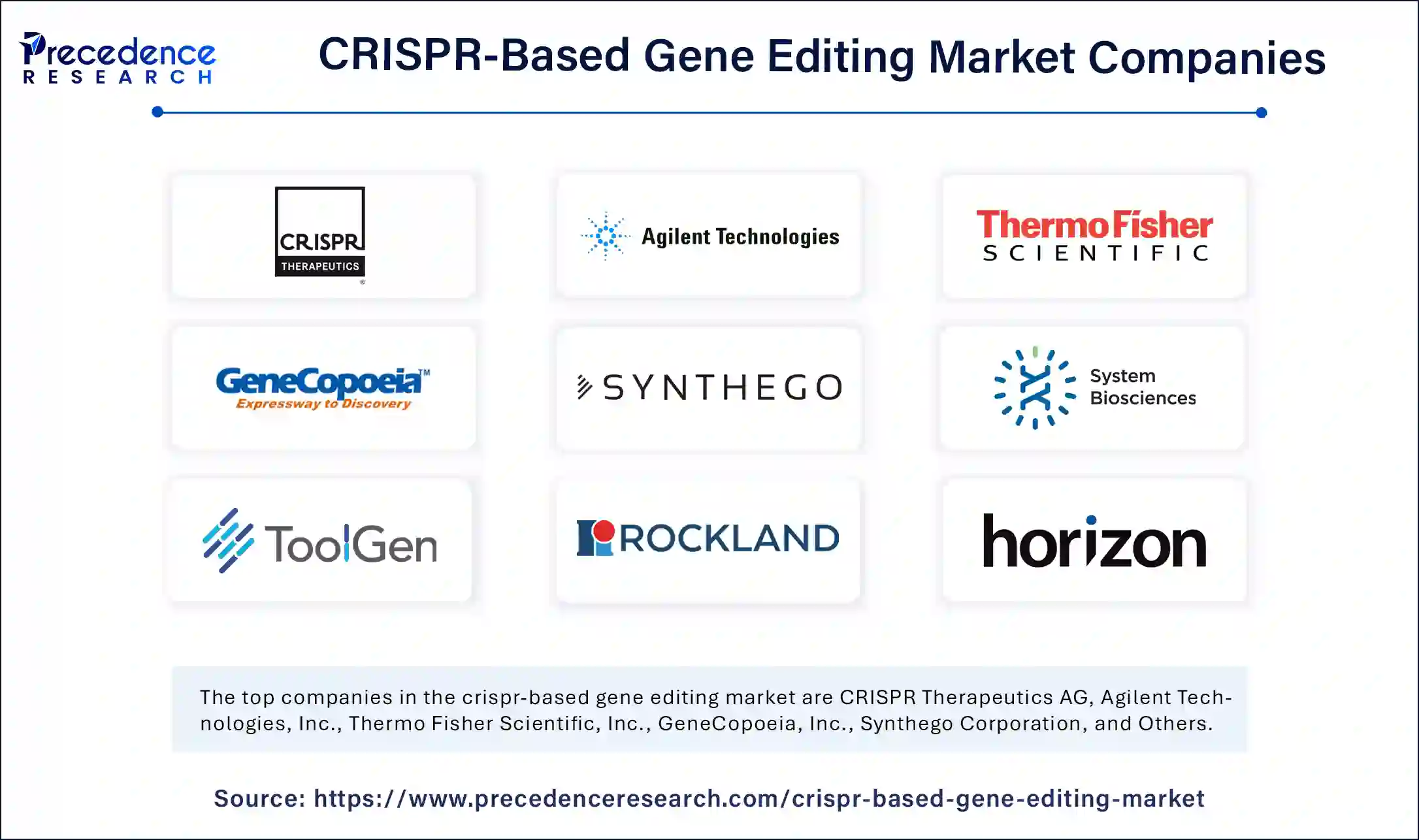
By Product
By Gene Editing Modality
By Technology
By Application
By End User
By Geography
For inquiries regarding discounts, bulk purchases, or customization requests, please contact us at sales@precedenceresearch.com
No cookie-cutter, only authentic analysis – take the 1st step to become a Precedence Research client
February 2025
January 2025
February 2025
November 2024